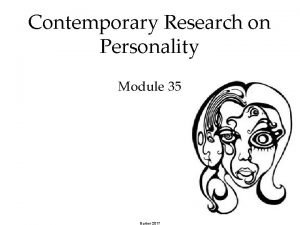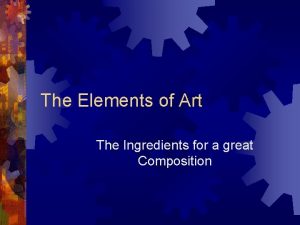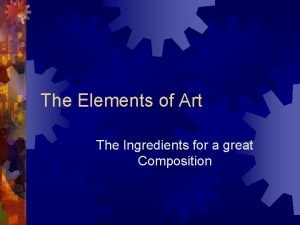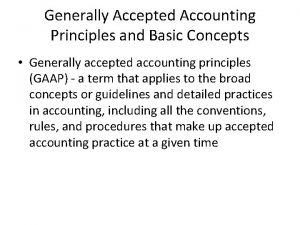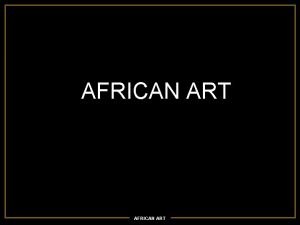African Art African art generally used as a



















- Slides: 19

African Art • African art generally used as a blanket term • the continent is full of people, societies, and civilizations, each with a unique visual special culture


• Along with sub-Saharan Africa, the cultural arts of the western tribes, ancient Egyptian paintings and artifacts, and indigenous southern crafts also contributed greatly to African art. • Often depicting the abundance of surrounding nature, the art was often abstract interpretations of animals, plant life, or natural designs and shapes.

• The origins of African art lie long before recorded history. • African rock art in the Sahara in Niger preserves 6000 -year-old carving • The earliest known sculptures are from the Nok culture of Nigeria, made around 500 BC. •

Nok • One of the earliest African centers of ironworking and terracotta figure production • The first known sculptures in Africa are by the Nok people of Central Nigeria, dating back from 500 BC to AD 200. The sculptures molded out of clay take the form of human figures and heads



• A very huge gap marks the history of African art after this period. Most of the surviving authentic ancestral masterpieces are crafted between the 14 th to the 17 th century. This is due to the fact that most of the materials that were available in this bridging period were perishable. • The tribes had used various kinds of wood, textiles, plant fibers and leather. And these objects were sooner or later worn and eventually damaged due to their everyday and intensive use in rituals and ceremonies.

• Among the most ingenious and technically advanced innovation in African artwork include the bronze work of the Igbo-Ukwu. • Excavations revealed a great number of intricately detailed bronze sculptures in the form of castings for royal purpose and ritual vessels.

Igbo Ukwu bronze ceremonial vessel made around the 9 th century AD. . . British Museum

• The most significant and among the earliest occurrence of realism is noted in the works of the Yoruba people of Ilé-Ifè. Among their native masterpieces include naturalistic stone, bronze, and terracotta sculptures. The sophisticated artistic culture of the Yoruba was more highlighted on the discoveries of sensational life-sized bronze and terracotta figures between the 1910 and 1930.

• Yoruba bronze head from Nigeria 12 century CE

• kings head in British Museum

Main characteristics • Emphasis on the human figure: The human figure has always been the primary subject matter for most African art • Visual abstraction: African artworks tend to favor visual abstraction over naturalistic representation. This is because many African artworks generalize stylistic norms

• Emphasis on sculpture: African artists tend to favor three-dimensional artworks over two-dimensional works. Even many African paintings or cloth works were meant to be experienced threedimensionally.

• House paintings are often seen as a continuous design wrapped around a house, forcing the viewer to walk around the work to experience it fully; while decorated cloths are worn as decorative or ceremonial garments, transforming the wearer into a living sculpture.


• Great inspiration and influence for various modern art movements like Cubism and Expressionism • Especially its impact on Picasso is very clear

Picasso’s work compared with an African mask
 Brainpop weather
Brainpop weather Sound waves from a radio generally travel in which medium
Sound waves from a radio generally travel in which medium Whats a prepositional phrase
Whats a prepositional phrase In a minimum cardinality, minimums are generally stated as
In a minimum cardinality, minimums are generally stated as Relatively permanent change meaning
Relatively permanent change meaning Alicia has started a new and very different job
Alicia has started a new and very different job When to use comma before because
When to use comma before because The chaparral biome is best characterized by _______.
The chaparral biome is best characterized by _______. With the block format, all new paragraphs are indented.
With the block format, all new paragraphs are indented. An access matrix is generally dense.
An access matrix is generally dense. Describe the draping procedure for a shampooing service
Describe the draping procedure for a shampooing service Viohalco
Viohalco Culture and society are intricately related
Culture and society are intricately related Shapes that have smooth even edges and are measurable
Shapes that have smooth even edges and are measurable Shapes that have smooth edges and are measurable
Shapes that have smooth edges and are measurable Shapes that have smooth even edges and are measurable
Shapes that have smooth even edges and are measurable Generally, people use facial management techniques to
Generally, people use facial management techniques to Ethnic identity examples
Ethnic identity examples Pengertian gaap
Pengertian gaap It is generally refers to human movement
It is generally refers to human movement





